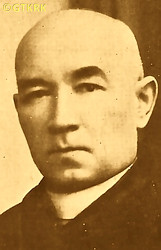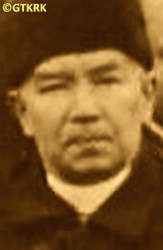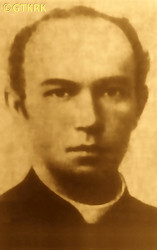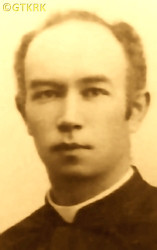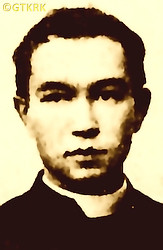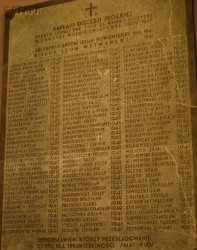Roman Catholic
St Sigismund parish
05-507 Słomczyn
85 Wiślana Str.
Konstancin deanery
Warsaw archdiocese, Poland
full list:
displayClick to display full list

searchClick to search full list by categories
wyświetlKliknij by wyświetlić pełną listę po polsku

szukajKliknij by przeszukać listę wg kategorii po polsku

Martyrology of the clergy — Poland
XX century (1914 – 1989)
personal data
surname
CHARSZEWSKI
forename(s)
Paulinus Ignatius (pl. Paulin Ignacy)
function
diocesan priest
creed
Latin (Roman Catholic) Church RCmore on
en.wikipedia.org
[access: 2014.09.21]
diocese / province
Płock diocesemore on
en.wikipedia.org
[access: 2013.05.19]
Włocławek diocesemore on
en.wikipedia.org
[access: 2013.05.19]
honorary titles
honorary canonmore on
en.wikipedia.org
[access: 2014.11.14]
(Annunciation to the Blessed Virgin Mary RC collegiate church, Pułtusktoday: Pułtusk gm., Pułtusk pov., Masovia voiv., Poland
more on
en.wikipedia.org
[access: 2021.12.18])
date and place
of death
21.04.1940

KL Sachsenhausenconcentration camp
today: Sachsenhausen‐Oranienburg, Oberhavel dist., Brandenburg state, Germany
more on
en.wikipedia.org
[access: 2018.11.18]
alt. dates and places
of death
14.04.1940
details of death
After German and Russian invasion of Poland in 09.1939 and start of the World War II, after start of German occupation, arrested by the Germans on 05.11.1939.
Jailed prob. in VSH Dembowalonka camp in Dębowa Łąka and on 07.12.1939 in VSH Culm camp in Chełmno.
From there on 21.03.1940 moved to KL Stutthof concentration camp.
Finally on 09‐10.04.1940 transported to KL Sachsenhausen concentration camp, where perished 4 days aftrer arrival — unable as on old man to comply with orders issued by sadistic Germans, continuously maltreated, finally after 3 days beaten virtually do death by a German guard.
According to the death certificate in the books of the Germ. Standesamt (Eng. registry office) in Oranienburg, No. 2125/40, the „honest” otherwise German „medical doctors” and formalists — and at the same time, unrivaled fairy tale spinners — noted that the cause of death was Germ. „Lungenentzündung, Herzschwäche” (Eng. „Pneumonia, heart failure”).
prisoner camp's numbers
20960Click to display source page (KL SachsenhausenClick to display the description)
cause of death
murder
perpetrators
Germans
sites and events
KL SachsenhausenClick to display the description, KL StutthofClick to display the description, VSH CulmClick to display the description, VSH DembowalonkaClick to display the description, «Intelligenzaktion»Click to display the description, Reichsgau Danzig‐WestpreußenClick to display the description, Ribbentrop‐MolotovClick to display the description, Pius XI's encyclicalsClick to display the description
date and place
of birth
22.06.1869Birth certification on:
www.genealogiawarchiwach.pl
[access: 2025.09.08]

Kołotoday: Koło urban gm., Koło pov., Greater Poland voiv., Poland
more on
en.wikipedia.org
[access: 2021.12.18]
parents
CHARSZEWSKI Francis
🞲 ?, ? — 🕆 ?, ?

CZERMIŃSKA Emily
🞲 ?, ? — 🕆 ?, ?
baptism
01.11.1869Birth certification on:
www.genealogiawarchiwach.pl
[access: 2025.09.08]

Dobrzyń nad Wisłątoday: Dobrzyń nad Wisłą gm., Lipno pov., Kuyavia‐Pomerania voiv., Poland
more on
en.wikipedia.org
[access: 2021.12.18]
Assumption of the Blessed Virgin Mary RC church
presbyter (holy orders)
ordination
08.04.1894

positions held
1932 – 1939
parish priest — Dobrzyń nad Drwęcątoday: district of Golub‐Dobrzyń, Golub‐Dobrzyń gm., Golub‐Dobrzyń pov., Kuyavia‐Pomerania voiv., Poland
more on
en.wikipedia.org
[access: 2021.09.02] ⋄ St Catherine of Alexandria the Virgin and Martyr RC parish ⋄ Rypintoday: Rypin gm., Rypin pov., Kuyavia‐Pomerania voiv., Poland
more on
en.wikipedia.org
[access: 2021.12.18] RC deanery
1912 – 1932
parish priest — Szpetaltoday: Szpetal Górny, Fabianki gm., Włocławek city pov., Kuyavia‐Pomerania voiv., Poland
more on
en.wikipedia.org
[access: 2021.12.18] ⋄ St Josaphat RC parish ⋄ Lipnotoday: Lipno gm., Lipno pov., Kuyavia‐Pomerania voiv., Poland
more on
en.wikipedia.org
[access: 2020.11.01] RC deanery
1905 – 1912
parish priest — Trzepowotoday: neighborhood in Płock, Płock city pov., Masovia voiv., Poland
more on
en.wikipedia.org
[access: 2021.12.18] ⋄ St Alex RC parish ⋄ Płocktoday: Płock city pov., Masovia voiv., Poland
more on
en.wikipedia.org
[access: 2021.12.18] RC deanery
1902 – 1905
curatus/rector/expositus — Żuromintoday: Żuromin gm., Żuromin pov., Masovia voiv., Poland
more on
en.wikipedia.org
[access: 2021.12.18] ⋄ Holy Trinity RC church ⋄ Lubowidztoday: Lubowidz gm., Żuromin pov., Masovia voiv., Poland
more on
en.wikipedia.org
[access: 2021.12.18], St Andrew the Apostle RC parish
1901 – 1902
vicar — Płocktoday: Płock city pov., Masovia voiv., Poland
more on
en.wikipedia.org
[access: 2021.12.18] ⋄ Assumption of the Blessed Virgin Mary RC cathedral parish
1900 – 1901
vicar — Warsawtoday: Warsaw city pov., Masovia voiv., Poland
more on
en.wikipedia.org
[access: 2021.10.09] ⋄ Visitation of the Blessed Virgin Mary RC parish ⋄ Warsaw‐in‐urbedeanery name
today: Warsaw city pov., Masovia voiv., Poland RC deanery
1898 – 1900
vicar — Płocktoday: Płock city pov., Masovia voiv., Poland
more on
en.wikipedia.org
[access: 2021.12.18] ⋄ Assumption of the Blessed Virgin Mary RC cathedral parish
1896 – 1898
vicar — Wyszogródtoday: Wyszogród gm., Płock pov., Masovia voiv., Poland
more on
en.wikipedia.org
[access: 2021.12.18] ⋄ Holy Trinity RC parish ⋄ Wyszogródtoday: Wyszogród gm., Płock pov., Masovia voiv., Poland
more on
en.wikipedia.org
[access: 2021.12.18] RC deanery
1895 – 1896
vicar — Pułtusktoday: Pułtusk gm., Pułtusk pov., Masovia voiv., Poland
more on
en.wikipedia.org
[access: 2021.12.18] ⋄ Annunciation to the Blessed Virgin Mary RC collegiate church ⋄ St Matthew the Apostle and the Evangelist RC parish ⋄ Pułtusktoday: Pułtusk gm., Pułtusk pov., Masovia voiv., Poland
more on
en.wikipedia.org
[access: 2021.12.18] RC deanery
1894 – 1895
vicar — Wyszogródtoday: Wyszogród gm., Płock pov., Masovia voiv., Poland
more on
en.wikipedia.org
[access: 2021.12.18] ⋄ Holy Trinity RC parish ⋄ Wyszogródtoday: Wyszogród gm., Płock pov., Masovia voiv., Poland
more on
en.wikipedia.org
[access: 2021.12.18] RC deanery
1893 – 1894
student — Sankt Petersburgtoday: Saint Petersburg city, Russia
more on
en.wikipedia.org
[access: 2020.07.31] ⋄ philosophy and theology, Imperial Roman Catholic Spiritual Academy (1842‐1918)
1887 – 1893
student — Płocktoday: Płock city pov., Masovia voiv., Poland
more on
en.wikipedia.org
[access: 2021.12.18] ⋄ philosophy and theology, Theological Seminary
author of many books, e.g. „Dobrzyń on Drwęca River”, Płock 1938; „Kingdom of Satan”, Poznań 1935; „Satan's Sun”, Włocławek 1932; „On the Absolutism of the Providence Idea in History. Miracles and Catastrophes”, Warsaw 1928; „Philosophical–Religious Dialogues”, Vilnius 1913; „Modernists. Modernizers. Anti‐Modernists. Ours and Aliens”, 1910; „Second Journey to Darktown”, Warsaw 1909; „On the Burning Matter of School Youth in the Kingdom”, Płock 1907; „Blind Leaders”, Warsaw 1901; „Album of Catholic Celebrations. Religious Sketches”, Płock 1900; „Religious Revival in Science, Literature and Life”, Warsaw 1899; and hundreds of articles in the Catholic press
others related
in death
ADAMCZYKClick to display biography Stanislav, BRZĄKAŁAClick to display biography Victor, BURCZYKClick to display biography Felix, BYTOFClick to display biography Peter, CHYLARECKIClick to display biography Stanislav, CIEMNIAKClick to display biography Louis, CYBULSKIClick to display biography Stanislav, CZAKIClick to display biography Saturnin, CZAPIEWSKIClick to display biography Joseph Leonard, DEMSKIClick to display biography Vladislav, DOERINGClick to display biography Alexander, FIGATClick to display biography Henry, GOŃCZClick to display biography Bernard Ambrose, GORALClick to display biography Vladislav, GRZEBIELEWSKIClick to display biography Joseph, GUZClick to display biography Joseph Adalbert (Fr Innocent), HEVELKEClick to display biography Alexander Eugene John Oscar, HINZClick to display biography Francis Felix, HINZClick to display biography Thaddeus, JARZĘBSKIClick to display biography Stanislav Romualdo, JORDANClick to display biography Boleslav, KALINOWSKIClick to display biography Theodore, KARAMUCKIClick to display biography Edmund Leo, KARCZYŃSKIClick to display biography Cyril Methodius, KAŹMIERCZAKClick to display biography Bronislav Anthony, KLEINClick to display biography John Matthias, KOMPFClick to display biography January Sigismund, KONKOLEWSKIClick to display biography Joachim, KOWNACKIClick to display biography Bronislav, KOZUBEKClick to display biography Roman, KRAUZEClick to display biography Edmund, KRUPIŃSKIClick to display biography Louis, KUBIAKClick to display biography John (Bro. Norbert Mary), KUBICKIClick to display biography Steven Adam Marian, KUBISTAClick to display biography Stanislav, KUPILASClick to display biography Francis, LAPISClick to display biography Casimir, LENARTClick to display biography John, LICZNERSKIClick to display biography Constantine John, ŁOSIŃSKIClick to display biography Bernard Anthony, MACIĄTEKClick to display biography Stanislav Paul, MARCHLEWSKIClick to display biography Leonard, MATUSZEWSKIClick to display biography Francis Adam, MĄKOWSKIClick to display biography John, MĘŻNICKIClick to display biography Joseph, MICHNOWSKIClick to display biography Marian John, MITRĘGAClick to display biography Francis, MORKOWSKIClick to display biography Edmund, MOŚCICKIClick to display biography Joseph, NAGÓRSKIClick to display biography Paul Adalbert, NITSCHMANNClick to display biography Adam Robert, NOWAŃSKIClick to display biography Anthony, NOWICKIClick to display biography Alexander, OCHOŃSKIClick to display biography Charles Joseph (Fr Chris), OKOŁO–KUŁAKClick to display biography Anthony, PALUCHOWSKIClick to display biography Boleslav, PETRYKOWSKIClick to display biography Steven, PIASZCZYŃSKIClick to display biography Michael, PODLASZEWSKIClick to display biography Francis, POMIANOWSKIClick to display biography Vladislav, RADTKEClick to display biography Steven Boleslav, SĄSAŁAClick to display biography Theodore, SKOBLEWSKIClick to display biography Mieczyslav, SKOWRONClick to display biography Casimir, SOCHACZEWSKIClick to display biography Bronislav Peter, SWINARSKI–PORAJClick to display biography Nicholas Ignatius Bogusław, SYNOWIECClick to display biography Boleslav, SZUKALSKIClick to display biography John Wladysław, SZYMAŃSKIClick to display biography Bruno Peter John, ŚLEDZIŃSKIClick to display biography Joseph Marian, TUSZYŃSKIClick to display biography Joseph, TYMIŃSKIClick to display biography Anthony, WAWRZYNOWICZClick to display biography John, WĄSOWICZClick to display biography Sigismund, WIERZBICKIClick to display biography Sigismund Lawrence, WIERZCHOWSKIClick to display biography Fabian Sebastian, WILLIMSKYClick to display biography Albert, WŁODARCZYKClick to display biography Ignatius, WOHLFEILClick to display biography Robert, WRÓBLEWSKIClick to display biography Bronislav, ZAWISZAClick to display biography Valentine, ZIELIŃSKIClick to display biography Paul Nicholas, ZIEMSKIClick to display biography Alexander Felix, ZIENKOWSKIClick to display biography Vaclav, ŻUCHOWSKIClick to display biography Vaclav, BĄCZKOWSKIClick to display biography Francis, BOLTClick to display biography Felix, BREJSKIClick to display biography John Casimir, DEKOWSKIClick to display biography Francis, DERKACZEWSKAClick to display biography Stanislava (Sr Raphaella of the Holy Face), GALIKOWSKIClick to display biography Roman John, GNILKAClick to display biography Pauline (Sr Junilla), JONEKClick to display biography Martha (Sr Dygna), KOWNACKIClick to display biography Martin Stanislav, KUCZAClick to display biography Francesca (Sr Gorgonya), ŁĘGOWSKIClick to display biography Vladislav Leonard, RUCIŃSKIClick to display biography Francis, WILEMSKIClick to display biography Joseph Louis, ZAREMBAClick to display biography Felix Joseph Hubert, ZIEMIAŁKOWSKAClick to display biography Hedwig (Sr Dominica of the Sacred Wounds of Jesus), SZWEDOWSKIClick to display biography Ignatius Mieczyslav, ŚWIECZKOWSKIClick to display biography Alexander
sites and events
descriptions
KL Sachsenhausen: In Germ. Konzentrationslager (Eng. concentration camp) KL Sachsenhausen, set up in the former Olympic village in 07.1936, hundreds of Polish priests were held in 1940, before being transported to KL Dachau. Some of them perished in KL Sachsenhausen. Murderous medical experiments on prisoners were carried out in the camp. In 1942‐1944 c. 140 prisoners slaved at manufacturing false British pounds, passports, visas, stamps and other documents. Other prisoners also had to do slave work, for Heinkel aircraft manufacturer, AEG and Siemens among others. On average c. 50,000 prisoners were held at any time. Altogether more than 200,000 inmates were in jailed in KL Sachsenhausen and its branched, out of which tens of thousands perished. Prior to Russian arrival mass evacuation was ordered by the Germans and c. 80,000 prisoners were marched west in so‐called „death marches” to other camps, i.e. KL Mauthausen‐Gusen and KL Bergen‐Belsen. The camp got liberated on 22.04.1945. After end of armed hostilities Germans set up there secret camp for German prisoners and „suspicious” Russian soldiers. (more on: en.wikipedia.orgClick to attempt to display webpage
[access: 2018.11.18])
KL Stutthof: In German Germ. Konzentrationslager (Eng. concentration camp) KL Stutthof (then in Eastern Prussian belonging to Germany, today: Sztutowo village) concentration camp, that Germans started to build on 02.09.1939, a day after German invasion of Poland and start of the World War II, Germans held c. 110,000‐127,000 prisoners from 28 countries, including 49,000 women and children. C. 65,000 victims were murdered and exterminated. In the period of 25.01‐27.04.1945 in the face of approaching Russian army Germans evacuated the camp. When on 09.05.1945 Russians soldiers entered the camp only 100 prisoners were still there. In an initial period (1939‐1940) Polish Catholic priests from Pomerania were held captive there before being transported to KL Dachau concentration camp. Some of them were murdered in KL Stutthof or vicinity (for instance in Stegna forest). Also later some Catholic priests were held in KL Stutthof. (more on: stutthof.orgClick to attempt to display webpage
[access: 2018.11.18], en.wikipedia.orgClick to attempt to display webpage
[access: 2013.07.06])
VSH Culm: German Germ. Volksdeutscher Selbstschutzhaft (Eng. Volksdeutscher Selbstschutz custody) VSH, founded by the Germans in Chełmno. The main role in it was played by members of the genocidal paramilitary formation Germ. Volksdeutscher Selbstschutz — the decision to create Selbstschutz in the Polish lands occupied by German troops was made in Berlin on 08‐10.09.1939 at a conference headed by Reichsführer‐SS Heinrich Himmler (the formal order bears the data 20.09.1939), and the chaotically formed units were directly subordinated to the officers of the genocidal SS organization. As part of the «Intelligenzaktion» operation, i.e. the extermination of the Polish intelligentsia and leadership classes, the Germans held thousands of Poles in the court prison building in Chełmno, in temporary detention centers set up in the buildings of primary schools No. 1 and No. 2 in Chełmno, in a makeshift camp set up in the old Fort VIII in Klamry (part of the former Prussian Chełmno Fortress), and also from 10.1939 in the convent of the Daughters of Charity, i.e. the Grey Sisters FdlC in Chełmno (where from 07.12.1939 a dozen or so Polish priests were interned, brought mainly from the VSH Dembowalonka internment camp). A significant number of those held, including c. 19 Catholic priests, were murdered in Klamry; some were transported to the KL Stutthof concentration camp (including, on 22.03.1940, many Catholic priests who remained in custody, most of whom were also subsequently murdered). (more on: pl.wikipedia.orgClick to attempt to display webpage
[access: 2014.03.10])
VSH Dembowalonka: German Germ. Volksdeutscher Selbstschutzhaft (Eng. Volksdeutscher Selbstschutz custody) VSH for the clergy of Wąbrzeźno county. Established on 24‐25.09.1939, when Germans, members of the genocidal paramilitary Germ. Volksdeutscher Selbstschutz formation — the decision to create Selbstschutz in the Polish lands occupied by German troops was made in Berlin on 08‐10.09.1939 at a conference headed by Reichsführer‐SS Heinrich Himmler (the formal order bears the date 20.09.1939), and the chaotically formed units were directly subordinated to the officers of the genocidal SS organization ‐ in the Shepherd Sisters CSDP monastery–institute in Dębowa Łąka, c. 10 km from Wąbrzeźno, interned 30 Catholic priests from nearby parishes (on the same day, the Germans destroyed all roadside statues and crosses in Wąbrzeźno district). As part of the «Intelligenzaktion» operation — the extermination of the Polish intelligentsia (in Kurkocin, c. 4 km away, the Germans murdered then c. 500 Poles) — they were detained there till 06.12.1939, and then transported to another camp in Chełmno and next to KL Stutthof concentration camp. After the end of hostilities of World War II, in the years 1954‐1957, during the Russian occupation, one of the concentration and slave labor camps organized by Commie‐Nazi authorities in Russian republic prl for religious sisters and nuns during «Action X‐2». (more on: pl.wikipedia.orgClick to attempt to display webpage
[access: 2014.10.31])
«Intelligenzaktion»: German: «Intelligenzaktion» (English: „Intelligence Action”) — a German program of extermination of the Polish elite, mainly the intelligentsia and leadership layers, carried out from the beginning of the occupation in w 09.1939 to 04.1940, mainly in territories directly annexed to Germany, but also in the so‐called Germ. Generalgouvernement (Eng. General Governorate), where it was called «AB‐aktion». In the first phase, immediately after the beginning of the German occupation, during military operations carried out by the Germ. Wehrmacht (Eng. Armed Forces) and the genocidal units of the Germ. Einsatzgruppen (Eng. Operational Groups) of the Germ. Sicherheitspolizei (Eng. Security Police), i.e. SiPo, and Germ. Sicherheitsdienst des Reichsführers SS (Eng. Security Service of the Reichsführer SS), i.e. SD, organized by the Germ. Reichssicherheitshauptamt (Eng. Reich Main Security Office), i.e. RSHA, which followed the troops, carried out under the Germ. Unternehmen „Tannenberg” (Eng. Operation „Tannenberg”) — based on the so‐called Germ. Sonderfahndungsliste (Eng. Special Wanted Lists), i.e. proscription lists of Poles considered particularly dangerous to the Third Reich, prepared by the Zentralstelle II/P (Polen) unit of the German RSHA. Later, implemented by the German civilian occupation authorities and the genocidal unit of the Germ. Volksdeutscher Selbstschutz (Eng. Ethnic Germans Self‐Defense), whose members were Germ. Volksdeutsche (Eng. Ethnic Germans), i.e. representatives of the German minority in Poland. According to various sources, these lists, at the beginning of 09.1939, could have contained the details of 61,000—88,000 „dangerous” Poles — although these figures cannot be confirmed. In total, during this genocide, c. 50,000 teachers, Catholic priests, representatives of the landed gentry, freelancers, social and political activists, and retired military personnel were systematically and methodically murdered. Another 50,000 were sent to concentration camps, where only a negligible percentage survived. (more on: en.wikipedia.orgClick to attempt to display webpage
[access: 2014.10.04])
Reichsgau Danzig‐Westpreußen: After the Polish defeat in the 09.1939 campaign, which was the result of the Ribbentrop‐Molotov Pact and constituted the first stage of World War II, and the beginning of German occupation in part of Poland (in the other, eastern part of Poland, the Russian occupation began), the Germans divided the occupied Polish territory into five main regions (and a few smaller). The largest one was transformed into Germ. Generalgouvernement (Eng. General Governorate), intended exclusively for Poles and Jews and constituting part of the so‐called Germ. Großdeutschland (Eng. Greater Germany). Two were added to existing German provinces. From two other separate new provinces were created. Vistula Pomerania region was one of them, incorporated into Germany on 08.10.1939, by decree of the German leader Adolf Hitler (formally came into force on 26.10.1939), and on 02.11.1939 transformed into the Germ. Reichsgau Danzig‐Westpreußen (Eng. Reich District of Gdańsk‐West Prussia) province, in which the law of the German state was to apply. The main axis of the policy of the new province, the territory of which the Germans recognized as the Germ. „Ursprünglich Deutsche” (Eng. „natively German”), despite the fact that 85% of its inhabitants were Poles, was Germ. „Entpolonisierung” (Eng. „Depolonisation”), i.e. forced Germanization. C. 60,000 Poles were murdered in 1939‐1940, as part of the Germ. „Intelligenzaktion”, i.e. extermination of Polish intelligentsia and ruling classes, in c. 432 places of mass executions — including c. 220 Polish Catholic priests. The same number were sent to German concentration camps, from where few returned (over 300 priests were arrested, of whom c. 130 died in concentration camps). C. 124,000‐170,000 were displaced, including c. 90,000 to the Germ. Generalgouvernement. Poles were forced en masse to sign the German nationality list, the Germ. Deutsche Volksliste DVL. Polish children could only learn in German. It was forbidden to use the Polish language during Catholic Holy Masses and during confession. Polish landed estates were confiscated..To further reduce the number of the Polish population, Poles were sent to forced labor deep inside Germany. The remaining Poles were treated as low‐skilled labor, isolated from the Germans and strictly controlled — legally, three or three of them could only meet together, even in their own apartments. Many were conscripted into the German Wehrmacht army. After the end of hostilities of World War II, the overseer of this province, the Germ. Reichsstatthalter (Eng. Reich Governor) and the Germ. Gauleiter (Eng. district head) of the German National Socialist Party, Albert Maria Forster, was executed. (more on: en.wikipedia.orgClick to attempt to display webpage
[access: 2024.06.24])
Ribbentrop‐Molotov: Genocidal Russian‐German alliance pact between Russian leader Joseph Stalin and German leader Adolf Hitler signed on 23.08.1939 in Moscow by respective foreign ministers, Mr. Vyacheslav Molotov for Russia and Joachim von Ribbentrop for Germany. The pact sanctioned and was the direct cause of joint Russian and German invasion of Poland and the outbreak of the World War II in 09.1939. In a political sense, the pact was an attempt to restore the status quo ante before 1914, with one exception, namely the „commercial” exchange of the so‐called „Kingdom of Poland”, which in 1914 was part of the Russian Empire, fore Eastern Galicia (today's western Ukraine), in 1914 belonging to the Austro‐Hungarian Empire. Galicia, including Lviv, was to be taken over by the Russians, the „Kingdom of Poland” — under the name of the General Governorate — Germany. The resultant „war was one of the greatest calamities and dramas of humanity in history, for two atheistic and anti‐Christian ideologies — national and international socialism — rejected God and His fifth Decalogue commandment: Thou shall not kill!” (Abp Stanislav Gądecki, 01.09.2019). The decisions taken — backed up by the betrayal of the formal allies of Poland, France and Germany, which on 12.09.1939, at a joint conference in Abbeville, decided not to provide aid to attacked Poland and not to take military action against Germany (a clear breach of treaty obligations with Poland) — were on 28.09.1939 slightly altered and made more precise when a treaty on „German‐Russian boundaries and friendship” was agreed by the same murderous signatories. One of its findings was establishment of spheres of influence in Central and Eastern Europe and in consequence IV partition of Poland. In one of its secret annexes agreed, that: „the Signatories will not tolerate on its respective territories any Polish propaganda that affects the territory of the other Side. On their respective territories they will suppress all such propaganda and inform each other of the measures taken to accomplish it”. The agreements resulted in a series of meeting between two genocidal organization representing both sides — German Gestapo and Russian NKVD when coordination of efforts to exterminate Polish intelligentsia and Polish leading classes (in Germany called «Intelligenzaktion», in Russia took the form of Katyń massacres) where discussed. Resulted in deaths of hundreds of thousands of Polish intelligentsia, including thousands of priests presented here, and tens of millions of ordinary people,. The results of this Russian‐German pact lasted till 1989 and are still in evidence even today. (more on: en.wikipedia.orgClick to attempt to display webpage
[access: 2015.09.30])
Pius XI's encyclicals: Facing the creation of two totalitarian systems in Europe, which seemed to compete with each other, though there were more similarities than contradictions between them, Pope Pius XI issued in 03.1937 (within 5 days) two encyclicals. In the „Mit brennender Sorge” (Eng. „With Burning Concern”) published on 14.03.1938, condemned the national socialism prevailing in Germany. The Pope wrote: „Whoever, following the old Germanic‐pre‐Christian beliefs, puts various impersonal fate in the place of a personal God, denies the wisdom of God and Providence […], whoever exalts earthly values: race or nation, or state, or state system, representatives of state power or other fundamental values of human society, […] and makes them the highest standard of all values, including religious ones, and idolizes them, this one […] is far from true faith in God and from a worldview corresponding to such faith”. On 19.03.1937, published „Divini Redemptoris” (Eng. „Divine Redeemer”), in which criticized Russian communism, dialectical materialism and the class struggle theory. The Pope wrote: „Communism deprives man of freedom, and therefore the spiritual basis of all life norms. It deprives the human person of all his dignity and any moral support with which he could resist the onslaught of blind passions […] This is the new gospel that Bolshevik and godless communism preaches as a message of salvation and redemption of humanity”… Pius XI demanded that the established human law be subjected to the natural law of God , recommended the implementation of the ideal of a Christian state and society, and called on Catholics to resist. Two years later, National Socialist Germany and Communist Russia came together and started World War II. (more on: www.vatican.vaClick to attempt to display webpage
[access: 2023.05.28], www.vatican.vaClick to attempt to display webpage
[access: 2023.05.28])
sources
personal:
martyrologium.w.interia.plClick to attempt to display webpage
[access: 2012.11.23], polacywberlinie.plClick to attempt to display webpage
[access: 2013.05.19], znad-wisly.blogspot.comClick to attempt to display webpage
[access: 2021.12.18], www.genealogiawarchiwach.plClick to attempt to display webpage
[access: 2025.09.08], www.parafiaswaleksego.plock.opoka.org.plClick to attempt to display webpage
[access: 2013.06.23]
bibliographical:
„Płock diocese clergy martyrology during II World War 1939‐1945”, Fr Nicholas Marian Grzybowski, Włocławek–Płock 2002
„International Tracing Service (ITS), Bad Arolsen, GermanyClick to display source page”, Arolsen Archives
original images:
znad-wisly.blogspot.comClick to attempt to display webpage
[access: 2021.12.18], znad-wisly.blogspot.comClick to attempt to display webpage
[access: 2021.12.18], martyrologium.w.interia.plClick to attempt to display webpage
[access: 2012.11.23], znad-wisly.blogspot.comClick to attempt to display webpage
[access: 2021.12.18], znad-wisly.blogspot.comClick to attempt to display webpage
[access: 2021.12.18]
LETTER to CUSTODIAN/ADMINISTRATOR
If you have an Email client on your communicator/computer — such as Mozilla Thunderbird, Windows Mail or Microsoft Outlook, described at WikipediaPatrz:
en.wikipedia.org, among others — try the link below, please:
LETTER to CUSTODIAN/ADMINISTRATORClick and try to call your own Email client
If however you do not run such a client or the above link is not active please send an email to the Custodian/Administrator using your account — in your customary email/correspondence engine — at the following address:

giving the following as the subject:
MARTYROLOGY: CHARSZEWSKI Paulinus Ignatius
To return to the biography press below:
 Click to return to biography
Click to return to biography








